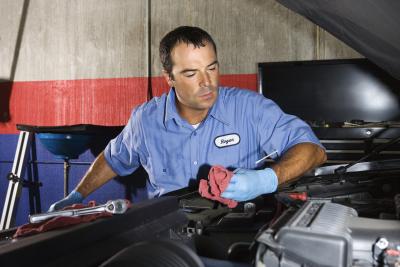
Ford equipped the F-250 truck's brake system with a dual-piston master cylinder. The master cylinder consists of a fluid reservoir and a cylinder body. The reservoir holds brake fluid for use by the hydraulic pistons and allows a visual check of the fluid level. The dual-piston system--one for the front brakes and one for the rear--operates when pressure is applied to the brake pedal. Hydraulic pressure from the master cylinder actuates the caliper pistons in the wheels which then press friction pads against the brake rotors to slow down the truck. Replace the master cylinder in the case of its wear or failure to keep the truck's brakes functioning as intended.
Raise the hood and disconnect the battery's negative cable with a wrench.
Loosen the hose clamp on the air cleaner's outlet tube with a screwdriver, then position the tube aside out of the way. Squeeze the tabs on the mass air-flow sensor's connector, then pull the connector apart. Remove the air-cleaner housing and set it aside.
Disconnect the fluid-level sensor's connector from the side of the master cylinder. Disconnect the brake-pressure switch's connector, if there is one, from the bottom of the master cylinder.
Remove the brake lines from the side of the master cylinder with a wrench.
Remove the master cylinder's mounting nuts with a wrench, then remove the master cylinder.
Reverse the disassembly procedure to install the new master cylinder. Tighten the mounting nuts to 20 ft-lbs. with a torque wrench. Tighten the brake lines to 18 ft-lbs.
Unscrew the cap on the master cylinder. Fill the master cylinder to the full line with brake fluid.
Place a box-end wrench over the bleed valve on the right-rear wheel. Attach the rubber hose to the bleed valve and submerge the other end of the hose into a cup or small container partially filled with brake fluid.
Employ your helper to slowly and gently pump the brake pedal a few strokes, then hold the pedal down. Turn the wrench to open the bleed valve. Watch the brake fluid in the container. Close the valve when air bubbles stop coming out the end of the tube. Repeat this step until no more air bubbles come out. Tighten the bleed valve to 26 ft-lbs. Check the level of brake fluid in the master cylinder. Top off the level as necessary.
Repeat steps 2 and 3 on the left-rear wheel, then the right-front wheel, then on the left-front wheel.
Replace the cap on the master cylinder. Pump the brakes to be certain there is a solid brake pedal before before moving the vehicle.